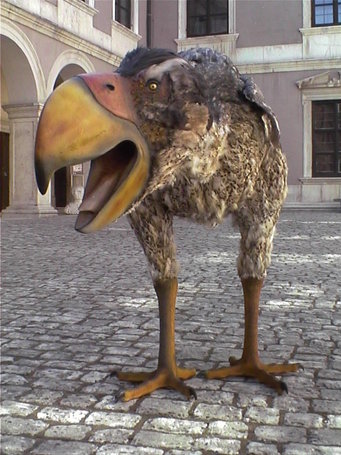Terror bird was frightening but harmless
The prehistoric bird Gastornis was probably not a bird of prey but a herbivore
The giant 2-m-tall prehistoric bird Gastornis, which roamed Europe in the Eocene epoch 55 to 40 million years ago, has apparently been wrongly accused of being the top predator of the time. For decades, paleontologists have speculated that it used its huge, fearesome beak to snap its prey´s neck and gave it the moniker "terror bird". Now, it seems, it was probably a vegetarian. This is the conclusion reached by a German research team, including Stephen Galer from the Max Planck Institute for Chemistry in Mainz, from analysis of the calcium isotopic composition of fossil bones from Gastornis. Isotopes are different forms of an element that have different weights. The amounts of "light" and "heavy" isotopes of calcium change in a systematic way as the calcium passes along the food chain, so this can be used to differentiate between herbivores and carnivores. Gastornis apparently belonged to the former.
The terror bird - also known as Gastornis - was a flightless, around two-meter-tall bird sporting an enormously large, intimidating beak. Due to its size and terrifying appearance, most scientists have assumed that it was carnivorous, and it would have been the top predator of the Eocene epoch. Depictions therefore most often illustrate Gastornis lunching on Eohippus, the diminutive ancestor of modern horses. But among paleontologists, it still remains a hotly debated topic – was Gastornis an awe-inspiring predator or just a benign oversized vegetarian?
The question of Gastornis' dietary preference may now be answerable based upon research from a German team consisting of Thomas Tütken from the University of Bonn, Meinolf Hellmund from the Martin Luther University in Halle, Stephen Galer from the Max Planck Institute for Chemistry and Petra Held from the University of Mainz. The new insights are based upon the application of a novel geochemical method. "By examining the calcium isotope composition of the fossilized bones we can determine the proportion of the terror bird's food derived from plant or animal tissue," explains Stephen Galer, group leader at the Max Planck Institute in Mainz. The scientist specializing in isotope biogeochemistry developed the analytical protocol for the calcium isotope analysis and evaluated the data obtained.

The team has shown that lighter isotopes of calcium become progressively enriched along a food chain, such that the proportion of lighter to heavy isotopes found in bones and teeth of carnivores is greater than those of herbivores. Using this observation, the researchers were able to assess the position occupied by Gastornis in the food chain of the ecosystem long ago in the Eocene epoch. They verified the method first with herbivorous and carnivorous mammals alive today and then for dinosaur ecosystems, which included analysing T-Rex, the apex predator of the Cretaceous period. Afterwards they analysed fossil bones from several Gastornis specimens held in the Geiseltal collection of the Martin Luther University in Halle, Germany.
This showed that the calcium in the bones of the terror bird bears most isotopic similarity to those of herbivorous mammals. Importantly, the proportion of heavy isotopes is far more than would be expected for carnivorous vertebrates. This suggests that Gastornis was not a meat eater at all but subsisted on a plant-based diet.
"The dental enamel preserves its geochemical properties much better than bones do. But as Gastornis had no teeth, we had to use bone samples for our isotopic analyses", explains Thomas Tütken from the University of Bonn. "Since calcium is an essential component of bone - it's about 40 percent of weight - it is very unlikely that the isotopic compositions were affected by the process of fossilization". To be completely sure, the researchers will be checking their results on Gastornis against further fossils of undisputed herbivores and carnivores found at the Geiseltal site in Saxony-Anhalt.
Details of this study were presented at the Goldschmidt Conference in Florence, which took place from August 25th to 30th, 2013.
